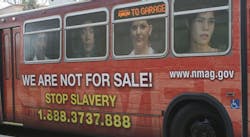Several recent legislative developments have reinforced the transit industry's ongoing effort to combat human trafficking. The federal Combatting Human Trafficking Commercial Vehicles Act (S. 1536) was signed into law in January. Additionally, the No Human Trafficking on Our Roads Act (S. 1532) directs the Department of Transportation to ban for life any driver who uses a commercial vehicle to commit a felony involving a severe form of human trafficking.
Much is happening at the state level as well. "Several states — including Ohio, Arkansas, Colorado, Texas and Kansas — have passed laws requiring anyone in pursuit of a CDL to complete human trafficking awareness training," said Kristen Joyner, executive director of the South West Transit Association. "California is working on something similar, and Arizona and Iowa now include human trafficking information in their CDL manuals."
Also in the state of Kansas, the Topeka City Council passed a resolution to combat human trafficking in April. The Shawnee County Commissioners later signed the same resolution. Additionally, the city of Topeka has partnered with Freedom Now USA — along with several state, local and federal law enforcement agencies — to combat human trafficking throughout Shawnee County. Freedom Now USA works to unite efforts to eradicate human trafficking across the country.
Susan Duffy, president of the Kansas Public Transit Association and CEO of Topeka Metro, is heading up the transportation component of that collaboration. "We know that to a certain extent, Kansas is a crossroads for human trafficking," Duffy pointed out. "It's not just the big cities. And it's just incredible that this is all going on in plain site."
Transit industry training and awareness
Over the past six years, the transit industry has helped lead the frontline effort to combat human trafficking. The DOT's Transportation Leaders Against Human Trafficking coalition has brought more than 200 organizations together to share resources on training, policy development and public awareness.
Transit agencies are taking steps to ensure that their employees are properly trained to react to a potential human trafficking situation.
"Part of it is being aware of what we call clues and tattoos," Joyner said. "Human traffickers often 'brand' their property. Some look like bar codes, often on the knuckles. Sometimes it's around the neck area like a chain. Sometimes it's on the back of the neck or between the shoulder blades. Sometimes it's a regular tattoo, and sometimes it is carved in."
Transit employees, particularly bus operators and customer service agents, are also trained on how to spot suspicious behavior. Joyner points to several warning signs:
- Someone who boards the bus is not in control of their own money or ID
- One person, often a young girl, takes a seat while an adult who followed her sits a few rows behind
- The potential trafficker has multiple cell phones
- The potential victim looks frightened and/or battered
"We never ask our employees to intervene in any situation," Joyner pointed out. "Transit agencies are developing standard processes for how operators can report what they see. Maybe they'll send a text or simply radio dispatch who will then alert law enforcement. Operators could also be instructed to call the Polaris hotline." Polaris is a leader in the global fight to eradicate human trafficking.
Transit can also help spread the message of human trafficking. Posters in depots, handouts on buses and trains, bus wraps, etc. are all helping to build public awareness.
Speaking of awareness, it's important for transit employees to be aware of their critical role in combatting human trafficking. They also need to be aware that their employers fully support them.
"I feel so good about our bus operators," Duffy said. "They get to know their passengers and their rhythms. When they see someone new or different, or simply sense that something isn't right, I want them to feel comfortable enough to call it in. There should be no second-guessing. It's better for it to turn out to be nothing than for something to get missed."
On the rail side of the industry, Amtrak has been helping to lead the fight since 2012. All Amtrak Police Department (APD) officers, train service, onboard service and station managers — along with their approximately 8,000 frontline employees — underwent human trafficking awareness training. Later, leveraging both printed materials and a computer-based training program from the Department of Homeland Security (DHS), Amtrak's broader workforce was trained.
Today, APD continues to be a partner in the DHS Blue Campaign by participating in yearly stakeholder events, assisting in the production of training materials, and distributing training to employees. That training includes reminders every January to review the computer-based training, as well as materials included in a new employee's onboarding package.
Visit transportation.gov/TLAHT for more information on how your transit agency can get involved in the fight to combat human trafficking.
